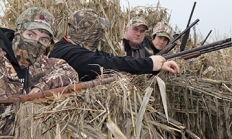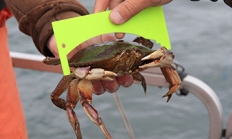Search myodfw.com
Features: Redtail surfperch all fins are reddish in color, and have 8-11 reddish to brownish vertical bars along the sides over a silver to brassy body. Habitat: Surfperch are found mostly in the surf. Redtail will usually be found between the 2nd and 4th row of breakers and near deeper holes and areas of high sand erosion. Technique: Some anglers use a #4 to #6 hook secured 24-30 inches below a 1- to 2-ounce sinker on 8- to 10-pound line. Baits include sand and kelp worms, sand shrimp, clam necks, and mussels. Some anglers have found success fly fishing for


Features: Black rockfish are dark gray to black on top, with a lighter belly, and black spots on their dorsal fins. They can grow to be 25-inches long. Take the "Black Rockfish or Not?" quiz Habitat: They are found over rocky reefs most typically shoreward of 180 ft. of depth, and are common along jetties and other structure in estuaries. Occasionally schools of black rockfish will come all the way to the surface. Technique: Rockfish feed on squid, octopus, krill, and other fish . They readily take both bait and lures. Common lures include rubber-tailed lead head jigs and shrimp

Features: These fish are dark blue or black with a light belly, a blotchy pattern on the sides, and no spots in the dorsal fin. The easiest way to distinguish a blue rockfish from a deacon rockfish is that the blues have jaws that meet together when closed. Habitat: Like all rockfish, these fish use rocky reefs as habitat. They are common down to 500 feet or more, but also come in to shallow areas. Blue rockfish will often suspend in large schools well off the bottom over rocky areas. Technique: They readily take both bait and lures. Blue rockfish

Features: Canary rockfish are named for their bright yellow to orange mottled bodies. They also have undertones of gray and three orange stripes across their heads. They grow to be 30-inches long, and have very firm and desirable meat. Habitat: Canary rockfish are a schooling fish, common along the Pacific Northwest coast over rocky reefs and pinnacles. Larger adults are usually further offshore, with younger fish sometimes common down to 100 feet. Yelloweye, canary and vermillion rockfish can look similar. See this rockfish identification article for distinguishing features for each species. Technique: They readily take both bait and lures. Locate
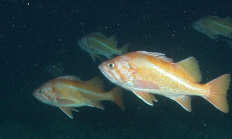
Features: These fish have a dark blue or black body, mottled with yellow and with a broad yellow stripe running along their side. Habitat: The China rockfish dwells in relatively shallow water, 10- to 400-feet deep, on rocky reefs. Technique: They readily take both bait and lures. China rockfish will be caught in areas with lots of rocks and crevasses, and by keeping the bait or lure very close to the bottom.

Features: Copper rockfish have variable coloration, ranging from dark or olive-brown to copper with pink or yellow blotches. They can grow to be 23-inches long. They have very tall and strong dorsal fin spines, and a clear patch along the rear half of the lateral line. Habitat: They prefer rocky, shallow areas. Though these shy fish do not school, they sometimes form small groups around man-made structures such as jetties. Technique: Copper rockfish will most readily be caught by working rubber tail jigs or bait near the bottom in shallow rocky areas.
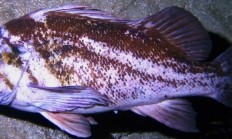
Features: These fish are dark blue or black with a light belly. In fact, they are closely related to blue rockfish, which are similar in appearance. The easiest way to identify a deacon rockfish is by the lower jaw that extends forward creating a significant underbite. Habitat: Like all rockfish, these fish use rocky reefs as habitat, but commonly suspend well up off the bottom. They are common down to 300 feet or more. Technique: They readily take both bait and lures. Deacon rockfish have smaller mouths than the black rockfish and are more likely to take smaller jigs and

Features: Quillback rockfish are slate-brown and mottled with yellow and orange towards the head, while the rear half of their body is gray to dark brown or black. They have dark brown or black "freckles" on their head and gill cover. They have deeply incised membranes on their very long, spinous dorsal fins. Quillback rockfish can grow to be 24-inches long. Habitat: They prefer rocky bottoms from the intertidal zone out to 800 feet. Technique: Quillback rockfish are currently prohibited. Anglers are required to immediately descend back to depth any quillback rockfish encountered outside of the 30-fathom regulatory line and

Features: Its deep red sides are mottled with gray. They grow to be 30-inches long. Yelloweye, canary and vermillion rockfish can look similar. See this rockfish identification article for distinguishing features for each species. Habitat: The vermilion rockfish is found near the bottom of the ocean over rocky substrate. Technique: They readily take both bait and lures. Rubber tailed lead head jigs, metal jigs, shrimp flies, and baited hooks will all take vermilion rockfish. Header photo by Ratha Grimes, Flickr
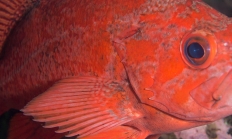
Features: The widow rockfish is brassy brown with a light colored belly. Their fin membranes are also brown. They can grow to be 21-inches long. Habitat: Widow rockfish school down to 1200 ft., usually found suspended over offshore reefs and rocky areas. Technique: Best success will be by first locating suspended schools of widow rockfish in offshore areas during periods open for fishing offshore, and then working rubber tail jigs or shrimp flies through the schools.

The Fisher is considerably larger than the marten and males are considerably larger than females. It is more stockily built than the weasels, but is similar in that the head is somewhat pointed, the body elongate, and the legs short. The pelage is long except on the face. The fur is dark brown grading to black on the rump and legs; the tail is black. Fishers once occurred throughout the coniferous and mixed forests of Oregon's Coast Range and Cascade Mountains. Currently, there is a native population in the Siskiyou Mountains and an introduced populations in the southern Cascades that

To get started on your next outdoor hunting adventure, the Oregon landscape offers the most diverse and accessible game bird hunting opportunities. Choose from migratory, to upland, to waterfowl, to turkey or all the above; this state offers thousands of acres to hunt in the most beautiful landscapes. Visit the current e-regulations below or pick up a printed copy at any license service agent or ODFW office location. Visit e-regulations
Searching for frogs and salamanders is a great way to introduce kids to the wonders of Oregon's wildlife and the great outdoors. Learn more about their various habitat needs and you'll increase your chances of seeing one of these unique species. Remember to leave no trace to preserve their habitat. Listen to a chorus of treefrogs, and check out our fun facts on Oregon's frogs.
Shellfish licenses are valid from Jan. 1 to Dec. 31. You can buy next year's license on Dec. 1 to plan ahead. If you have questions, please call ODFW licensing staff at 503-947-6101. Check current Sport Fishing Regulations for details on licenses, tags, permits and validations. *Use current published regulations by downloading a .pdf on your device. (AI-may contain inaccurate data).
Oregon boasts dozens of species of game fish. Trout is the most popular target for anglers, but the state also has iconic salmon and steelhead runs, world-class smallmouth bass fisheries and marine opportunities for both shore and boat anglers.
Hunting licenses are valid from Jan. 1 to Dec. 31. You can buy next year's license on Dec. 1 to plan ahead. If you have questions, please call ODFW licensing staff at 503-947-6101. Check current Big Game Regulations for details on licenses, tags, permits and validations. *(Use of AI is unreliable and may contain inaccurate data concerning rules and regulations).


